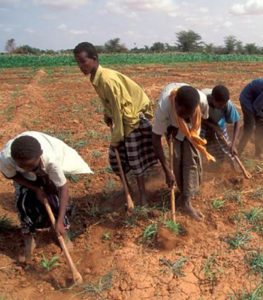Rural poverty driving migration – FAO report
Poverty linked to climate change and the degradation of agriculture is emerging as a major driver of international migration, according to a new report from the UN’s Food and Agriculture  Organisation (FAO).
Organisation (FAO).
The total number of international migrants increased from 173 million to 258 million, and as many as 25 million are refugees who left their countries to escape conflicts and other crises.
But according to the FAO’s 2018 State of Food and Agriculture report most migration isn’t a result of crisis – it’s a product of, and a solution to, persistent inequalities.
As some societies get richer while others get poorer, people move to access better opportunities for themselves and their families, the report argues.
“The FAO’s mandate is closely linked to development, and when it comes to development, migration cannot be ignored,” said Andrea Cattaneo, a senior FAO economist and report author.
But the benefits of migration are not universal, the report says.
Just as migration can reduce inequalities, it can create more problems for those who stay behind and better policies are needed to maximize migration’s opportunities while reducing its harmful effects, the report says.
It says that migration is primarily a rural phenomenon and that migration within countries is significantly larger than between countries and is as much as four times the amount. And eighty per cent of internal movements involve a rural area.
Natural disasters, violent conflicts, and resource depletion are all causes of rural migration, but poverty is the main reason why people leave their homes, the report says.
A World Bank study found more than 75 per cent of the world’s poor are located in rural areas, and, for many, relocating offers the chance for greater prosperity.
“People move because of better opportunities, and today more information is available to potential migrants about opportunities compared to 25 years ago,” the FAO report says.
Many migrants move to urban areas seeking higher paying jobs in the service and manufacturing sectors, along with better education, healthcare, and social protection, it says.
Others move from one rural location to another, especially in high-income regions where foreign workers are an important source of agricultural labour.
“Rural migration, in all its forms, constitutes a critical portion of both internal and international migration. Therefore, it is central to the migration debate,” the report says.
Despite its potential benefits, the opportunities provided by rural migration are highly circumstantial.
Migration has significant, but mixed impacts on rural areas and agriculture. The net effect may be either positive or negative, the report says.
“For example, significant migration out of overpopulated rural areas can have a positive impact by shrinking the local labor pool and causing local wages to rise,” it says.
“Meanwhile, migration into regions with a low rural population can fill critical labour shortages in agriculture.
“When they’re abroad, migrants working higher paying jobs tend to send surplus income to their families.
“When they return home, many migrants bring new skills, knowledge, and ideas, which can contribute to economic and social development in their communities,” the report says.
But not all communities benefit from migration, however. When too many members of a community leave, households can become overworked, causing them to abandon their farmland.
Also, younger generations are more likely to migrate, leaving a vulnerable and aging workforce at home, the report says.
Another problem is that many migrants face mistreatment and inequality when they move. Many migrants work informally, earn less than legal salaries, and perform dangerous work with inadequate safety measures, it says.
Meanwhile, racism, language barriers, and inadequate social protections predispose foreign workers to isolation and exploitation.
“Migration does not always have positive impacts. There are costs and challenges to the migrants themselves, their communities of origin, and their destination,” the report says.
The FAO says that better policies linked to agriculture and rural development can maximize the benefits of migration while minimizing its potential harm to individuals and communities.
One recommendation is to make migration easier. Governments can assist migrants find seasonal employment and relocate.
In destination regions, authorities can improve and better enforce workers’ rights to protect migrants from exploitation.
Helping and encouraging migrants to return home can facilitate the transfer of money, knowledge, and skills to their home communities.
Another approach, the report’s authors say, is to remove the need for migration altogether.
“In my view, an environmentally, socially, and economically sustainable food system is one in which migration from rural areas is an option but not a necessity,” Mr Cattaneo said.
“In other words, migration, rather than prevailing as a necessity for many rural communities, must become a voluntary choice between beneficial opportunities.
“Investing in the infrastructure and institutions necessary for a sustainable food system will improve livelihoods in rural areas,” Mr Cattaneo said.
“This will allow those who want to stay to stay, and those who want to leave to migrate. This is a key prerequisite for maximizing the benefits of migration.”
Laurie Nowell
AMES Australia Senior Journalist












